
Comparative Study of Post-Marriage Nationality Of Women in Legal Systems of Different Countries
The Effect of Fear of Missing Out on Impulse Buying in the Context of S-Commerce
401
International Journal of Multicultural
and Multireligious Understanding
http://ijmmu.com
editor@ijmmu.com
ISSN 2364-5369
Volume 11, Issue7
July, 2024
Pages: 401-407
The Effect of Fear of Missing Out on Impulse Buying in the Context of
S-Commerce
Ni Luh Debby Maharani Eka Putri1; Sulhaini2; Akhmad Saufi2
1 Master of Management, Faculty of Economics and Business, University of Mataram, Mataram, Indonesia
2 Department of Management, Faculty of Economics and Business, University of Mataram, Mataram, Indonesia
http://dx.doi.org/10.18415/ijmmu.v11i7.5942
Abstract
This research aims to analyze the influence of Fear of Missing Out (FOMO) on impulse buying
and the moderating role of price discounts, focusing on local skincare brands in Indonesian social
commerce (s-commerce). The population of this research is female consumers in Indonesia who have
bought local skincare products on s-commerce. The sample for this research is 150 people. Data
collection was carried out through an online survey using Google Forms. The approach used in this
research is associative quantitative, with SEM-PLS used as the data analysis technique. The research
results found that FOMO has a positive and significant effect on impulse buying, but price discounts do
not strengthen the influence of FOMO on impulse buying.
Keywords: FOMO; Price Discounts; Impulse Buying
Introduction
The digital era has revolutionized how consumers shop, shifting the trend from purchasing from
physical stores to s-commerce platforms. The use of social media as a marketplace has created a new
phenomenon called social commerce (s-commerce), where interactions between producers and consumers
become broader and more intense, involving Website 2.0 technology and social media (Esmaeili and
Hashemi, 2019). In Indonesia, s-commerce platforms such as Shopee, Tokopedia, and Lazada
experienced rapid growth between 2018 and 2023, with the number of users reaching 196.47 million,
attracting millions more looking for convenience and product variety (dataindonesia.id). One product
category that has been increasingly in demand is local skincare.
With the convenience and variety of choices offered by s-commerce, certain patterns of buying
behavior may emerge, such as impulsive purchases. According to Alfina et al. (2023), impulsive
purchases tend to occur more frequently among individuals with high levels of fear of missing out
(FOMO) when they worry about being left behind by social media trends. Another study by Muharam et
al. (2023) confirmed that FOMO significantly impacts impulsive buying in s-commerce.
The development of s-commerce has also impacted business actors significantly, prompting the
development of various marketing strategies to attract consumers, including advertising, product

International Journal of Multicultural and Multireligious Understanding (IJMMU)
Vol. 11, No. 7, July 2024
The Effect of Fear of Missing Out on Impulse Buying in the Context of S-Commerce
402
innovation, and price discounts. These strategies can increase purchasing interest and may trigger
impulsive buying in s-commerce. For example, Simanjuntak (2022) shows that price discounts have
triggered Shopee’s s-commerce application users to make impulsive purchases.
Past research has provided empirical evidence that s-commerce platforms increase the likelihood
of impulse purchases among digital consumers. Research conducted by Christy (2022) has shown that
individuals with FOMO have the urge to make purchases that were not previously planned or desired,
resulting in impulsive shopping. Suhardi et al. (2023) also stated that individuals who experience FOMO
become insensitive to prices, which means that consumers will continue to make purchases without
considering the prices to avoid feeling anxious.
While the effect of FOMO on impulse buying has been studied, there are still research gaps that
need to be answered. First, the moderating role of price discounts on the link between FOMO and impulse
buying has not been examined. Second, previous studies on consumer behavior relating to local skincare
products in the context of s-commerce are still limited. Therefore, this research aims to fill the gaps by
examining the link between FOMO and impulsive buying and the moderating role of price discounts to
uncover consumer behavior toward local skincare products in s-commerce.
Halim et al. (2022) state impulse buying behavior is more influenced by consumer feelings and
emotions compared to rational thinking. They may regret their buying decisions later because most of the
products purchased are not really needed. Earlier, Hausman (2000) suggested that indicators of impulse
buying are 1) spontaneous, 2) buying immediately after seeing a product, 3) buying without thinking
carefully, and 4) deciding to purchase at will.
Furthermore, FOMO is an anxiety that occurs due to the fear of being left behind when other
people enjoy certain experiences, which are often impressive. People experiencing FOMO may feel the
urge to be connected or to follow what is happening on social media, indicated by feelings of fear, worry,
and anxiety (Przybylski et al., 2013).
In addition to FOMO, impulsive buying may be influenced by price discounts. The direct price
discounts for certain products are given by sellers to buyers within a certain period (Widjaya et al., 2016).
According to Qomarul Huda et al. (2021), price discounts are indicated by the percentage (size), period,
and product type. These factors often cause people to buy products without prior intentions.
Based on the previous studies outlined above, we formulate the following hypotheses:
H1: FOMO has a significant effect on impulsive buying in s-commerce.
H2: Price discounts moderate the impact of FOMO on impulsive buying.
Figure 1. Conceptual framework

International Journal of Multicultural and Multireligious Understanding (IJMMU)
Vol. 11, No. 7, July 2024
The Effect of Fear of Missing Out on Impulse Buying in the Context of S-Commerce
403
Research Methods
This research uses quantitative methods with an associative approach to test the relationship
between variables (Abdullah, 2015). Hypotheses are tested using empirical data from the field. Data was
collected from respondents in Indonesia by distributing questionnaires via social media. The sample
population was Indonesians who have shopped for local skincare products (Avoskin, Somethinc, Scarlett,
MS Glow, and others) through s-commerce applications operating in the Indonesian market (Tokopedia,
Lazada, Shopee, and others). The number of samples in this study was 150. The sampling technique used
was a non-probability sampling, namely purposive sampling. The hypothesis in this research was tested
using the Partial Least Square (PLS) method from the Structural Equation Model (SEM). This method
was chosen after testing the quality of the instrument using validity and reliability tests (Table 1). The
instrument testing and data processing in this research were assisted by SmartPLS 3.0 software.
Respondents in this study were dominated by women aged 22-26 years. In the job category, most
respondents worked in the private sector. Regarding the local skincare category, most respondents in this
study purchased a local skincare brand called Somethinc. Meanwhile, in the category of s-commerce
applications, most respondents used Shopee. Geographically, the largest percentages of respondents were
from Bali and Nusa Tenggara.
Outer Model Analysis
Table 1. Validity and Reliability Test Measurements
Symbol
Outer Loading
AVE
Cronbach's Alpha
Composite Reliability
FOMO (X) Przybylski
et al., (2013)
0.837
0.975
0.979
X1
0.894
X2
0.928
X3
0.946
X4
0.948
X5
0.950
X6
0.961
X7
0.943
X8
0.933
X9
0.704
Price Discount (Z)
Qomarul Huda et al.,
(2021)
0.861
0.980
0.982
Z1
0.905
Z2
0.921
Z3
0.929
Z4
0.940
Z5
0.926
Z6
0.954
Z7
0.925
Z8
0.922
Z9
0.926
Impulse Buying (Y)
Hausman (2000)
0.782
0.971
0.975
Y1
0.921
Y2
0.902
Y3
0.924

International Journal of Multicultural and Multireligious Understanding (IJMMU)
Vol. 11, No. 7, July 2024
The Effect of Fear of Missing Out on Impulse Buying in the Context of S-Commerce
404
Y4
0.940
Y5
0.899
Y6
0.940
Y7
0.849
Y8
0.909
Y9
0.862
Y10
0.721
Y11
0.835
The validity test results in this research show that all statements on the FOMO, price discounts,
and impulse buying variables have adequate validity values. The value of each statement on this variable
is more than 0.5, and the overall value is even more than 0.7. The minimum value for AVE validity is 0.5,
and the outer loading is 0.7, so it can be collected validity evidence supports the conclusion that all
research instrument items are valid.
Furthermore, the reliability test shows that the three research variables (FOMO, price discounts,
and impulse buying) have a high level of reliability. Cronbach's alpha and composite reliability values for
these three variables are greater than 0.7. The minimum value for reliability is 0.7, so it can be concluded
that all variables in this study are reliable.
Research Results
Inner Model Analysis Table 2. R Square Value
R Square
R Square Adjusted
Impulse Buying (Y)
0.630
0.622
This research examines how two variables, i.e., FOMO and price discounts, influence another
variable, i.e., impulse buying. The research results show that the FOMO and price discount variables can
explain 63% of the variation in impulse buying. In other words, 63% of respondents’ impulse buying
behaviors were influenced by FOMO and price discounts. The remainder 37% was influenced by other
factors not examined in this study.
Figure 2. Bootstrapping Path Coefficient Test

International Journal of Multicultural and Multireligious Understanding (IJMMU)
Vol. 11, No. 7, July 2024
The Effect of Fear of Missing Out on Impulse Buying in the Context of S-Commerce
405
Table 3. Interpretation of Hypothesis Test Results
Hypothesis
Influence Between
Variables
Original
Sample
t-Statistics
P Values
Information
H1
X.->Y
0.757
0.042
0,000
Proven
H2
Moderating Effect 1 -> Y
0.066
0.042
0.119
No Proven
Discussion
The FOMO on Impulse Buying
This research shows that FOMO significantly influences impulse buying of local skincare
products in s-commerce, as shown by a statistical t-value of 0.042 and a p-value of 0.000. A statistical t-
value smaller than 1.96 and a p-value smaller than 0.05 indicates that the relationship between FOMO and
impulse buying is statistically significant, which provides ample evidence to conclude that FOMO does
influence impulse buying of local skincare products in s-commerce in Indonesia.
The high statistical t-value (0.042) indicates the strength of the relationship between FOMO and
impulse buying. The higher the level of FOMO, the more likely a consumer is to make impulse purchases
of local skincare products in s-commerce. The small p-value (0.000) indicates that the results of this study
are very unlikely to occur by chance. This strengthens the conclusion that the relationship between
FOMO and impulse buying of local skincare products in s-commerce exists and is significant.
This finding aligns with research by Muharam et al. (2023), which shows that FOMO can
influence impulse buying behavior. Individuals with severe FOMO are more easily tempted to make
impulse purchases because they fear missing out on new trends or experiences. In the context of skincare,
FOMO can be manifested in fear of missing out on the newest products, the latest beauty trends, or the
dramatic results other people have claimed to achieve using certain skincare products. The anxiety and
fear induced by FOMO can encourage them to buy local skincare products on s-commerce without
considering their needs and budget. This can result in negative consequences, such as financial problems,
or psychological disturbance, like the feeling of regrets.
Price Discounts as a Moderating Variable of the Effect of FOMO on Impulsive Buying
The results of this study indicate that price discounts do not moderate the relationship between
FOMO and impulse buying of local skincare products in s-commerce. This is proven by a statistical t-
value of 0.042 and a p-value of 0.119. A p-value greater than 0.05 indicates that the moderating effect of
price discounts is not statistically significant. It does not modulate the impact of FOMO on impulse
buying.
This finding contradicts the research results by Afifah and Yulisa (2019), which show that price
discounts can moderate the relationship between FOMO and impulse buying. One possible explanation
for these differences in findings is the type of product examined in the studies. Previous research that
observed a moderating effect of price discounts focuses on higher-priced products, such as smartphones
or fashion items. Smartphones have multiple functions, such as communication, entertainment, and access
to information, so consumers may be more inclined to buy a new smartphone at a discount because they
see the value for money. On the other hand, the consideration of buying skin care products is more about
health and appearance, so consumers may focus more on the effectiveness and safety of skin care
products than price.
This is supported by research conducted by Ulmaghfiroh et al. (2021), which shows that price
discounts did not moderate the impact of product knowledge on purchase intentions. One explanation is


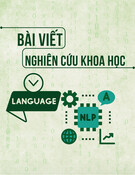



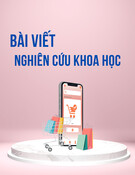


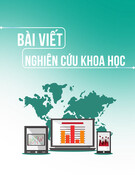

![Tài liệu học tập Quản trị bán hàng [mới nhất]](https://cdn.tailieu.vn/images/document/thumbnail/2025/20251009/lehanminhanh@gmail.com/135x160/59311759982292.jpg)
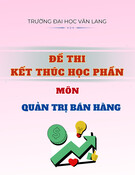



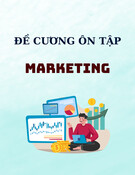
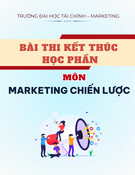
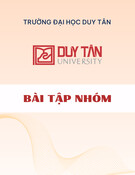
![Câu hỏi trắc nghiệm Nghiên cứu Marketing: Ôn tập kiểm tra [chuẩn nhất]](https://cdn.tailieu.vn/images/document/thumbnail/2025/20250925/kimphuong1001/135x160/29581758770138.jpg)






